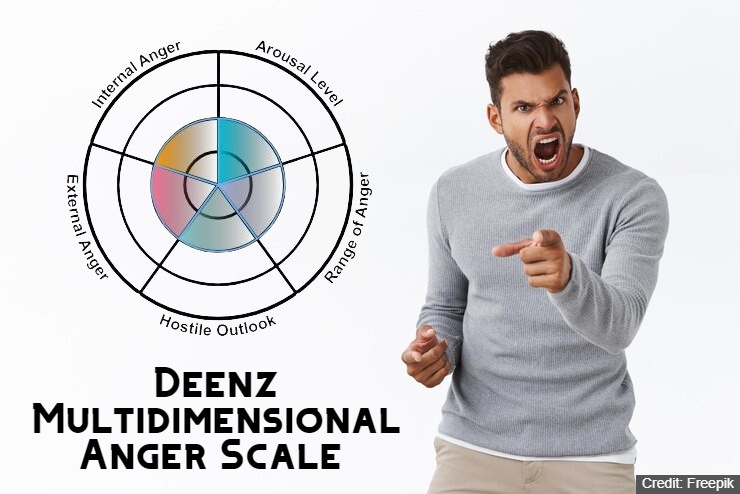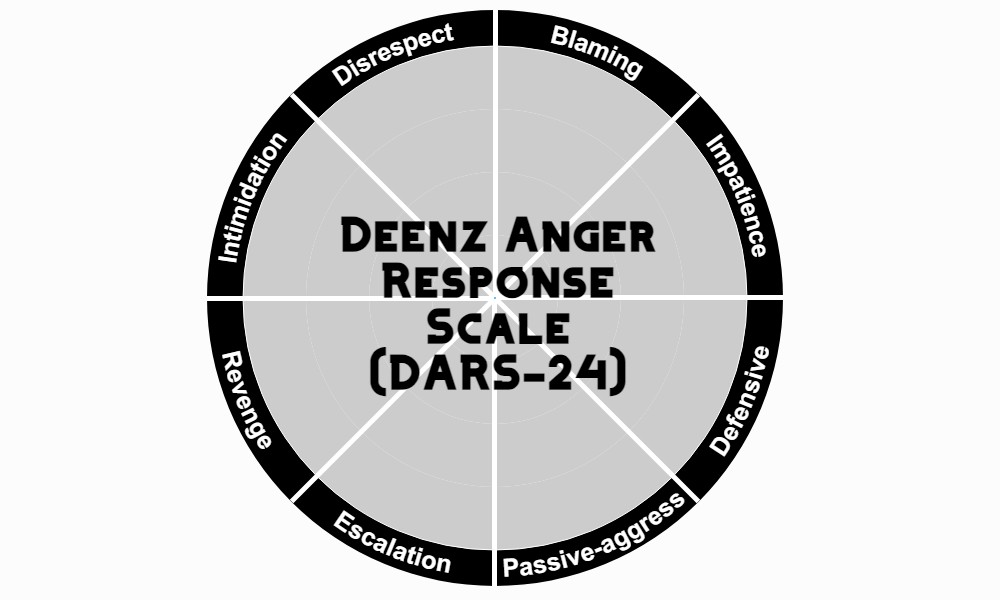Basic information | |
|---|---|
| Statements: | 20 |
| Duration: | 3–5 minutes |
| Type: | Self-assessment Quiz |
| Corresponding author: | Deen Mohd |
| Publishing year: | 2021 |
| Seminal paper: | Development and Validation of Deenz Multidimensional Anger Scale (DMAS-20) [Preprint] |
This quiz is based on the preliminary version of Deenz Multidimensional Anger Scale (DMAS-20). The quiz results and graphics are provided for educational purposes only. Your participation in this quiz is completely anonymous and results are NOT stored for research purposes. Only a mental health professional can make a proper diagnosis of Intermittent Explosive Disorder. For further information read our Privacy & Terms.
Anger, as a natural response, was previously studied as a singular emotional response to a perceived threat or frustration. Over the years, the understanding of anger as an emotional and behavioral domain has evolved .
Researchers emphasize recognizing this complex and multifaceted emotion as multidimensional, as it can be influenced by various factors, contexts, and expressions.
In 1986, JM Siegel published Multidimensional Anger Inventory (MAI), the inventory was designed to access multifaceted of anger experiences, including emotional, cognitive and behavioral aspects. In a Reliability and Factor Structure research conducted by Ralph Serin Daryl G Kroner 1992, it was found that some statements had relatively low item-remainder correlations.
Deenz Multidimensional Anger Scale (DMAS-20) was developed to measure the same dimensions of anger as the JM Siegel Multidimensional Anger Inventory (MAI). The main purpose of DMAS-20 is to provide a more nuanced understanding and measure of anger experiences with simple and good item-remainder correlation.
Understanding different dimensions of anger
Anger Arousal
The “anger arousal” dimension of anger refers to the frequency, magnitude, and duration of the physical and psychological response to a perceived threat. People who get a high score in this dimension respond quickly to perceived threats and have an increased heart rate, increased sweating, and an adrenaline response that prepares the body for fight or flight. If you got a high score in anger arousal, you may be experiencing anger in a different way, You may feel your heart pounding, your muscles becoming tense, and your breathing becoming more shallow. This is a normal and adaptive response to a perceived threat, and it prepares the body to respond quickly to the situation.
Range of Anger
People experience a range of emotions and intensities when feeling angry. From mild irritation to intense range, an individual can express and cope with anger differently. Some people experience anger more frequently or intensely than others. Anger can build up in lots of ways, like yelling, hitting things, and feeling grumpy. If you got high scores on this dimension, then it simply means that your frustrations turn into anger easily in a wide range of situations.
Hostile Outlook
If you got a high score in this dimension or facet of the emotion of anger, then it means you have a negative, aggressive, suspicious, and mistrustful way of perceiving others and the situation. People who have a high level of hostile outlook dimension are more likely to engage in aggressive behavior and face difficulties in their personal and professional lives.
External Anger
If you got a high score on the external anger scale, then it typically means that you have a tendency to externalize or vent your anger and frustration towards others or objects outside of yourself. You may find yourself yelling, and have behaviors such as criticism, or physical aggression. Such behaviors may cause others to ignore and withdraw from them, and they may face difficulties in their personal and professional lives.
Internal Anger
If you got a high score on this anger dimension scale, then it typically means that you have a tendency to internalize or bottle up your anger and feelings of frustration. You may find yourself suppressing or denying feelings of anger. This can lead to feelings of anxiety and negative emotional states. You may also find yourself feeling guilty for expressing your anger. You may also find that this negatively affects your relationships and makes you feel isolated and disconnected from others.
References
- Averill, J. R. (1983). Studies on anger and aggression: Implications for theories of emotion. American Psychologist, 38(11), 1145–1160. https://doi.org/10.1037/0003-066X.38.11.1145 ↩
- Van Coillie, H., Van Mechelen, I., & Ceulemans, E. (2006). Multidimensional individual differences in anger-related behaviors. Personality and Individual Differences, 41(1), 27-38. https://doi.org/10.1016/j.paid.2006.01.007 ↩
- Maiuro, R. D., Cahn, T. S., Vitaliano, P. P., Wagner, B. C., & Zegree, J. B. (1988). Anger, hostility, and depression in domestically violent versus generally assaultive men and nonviolent control subjects. Journal of Consulting and Clinical Psychology, 56(1), 17–23. https://doi.org/10.1037/0022-006X.56.1.17 ↩
- Siegel, J. M. (1986). The Multidimensional Anger Inventory. Journal of Personality and Social Psychology, 51(1), 191–200. https://doi.org/10.1037/0022-3514.51.1.191 ↩
- Kroner, D. G., Reddon, J. R., & Serin, R. C. (1992). The Multidimensional Anger Inventory: Reliability and Factor Structure in an Inmate Sample. Educational and Psychological Measurement. https://doi.org/10.1177/0013164492052003018 ↩






